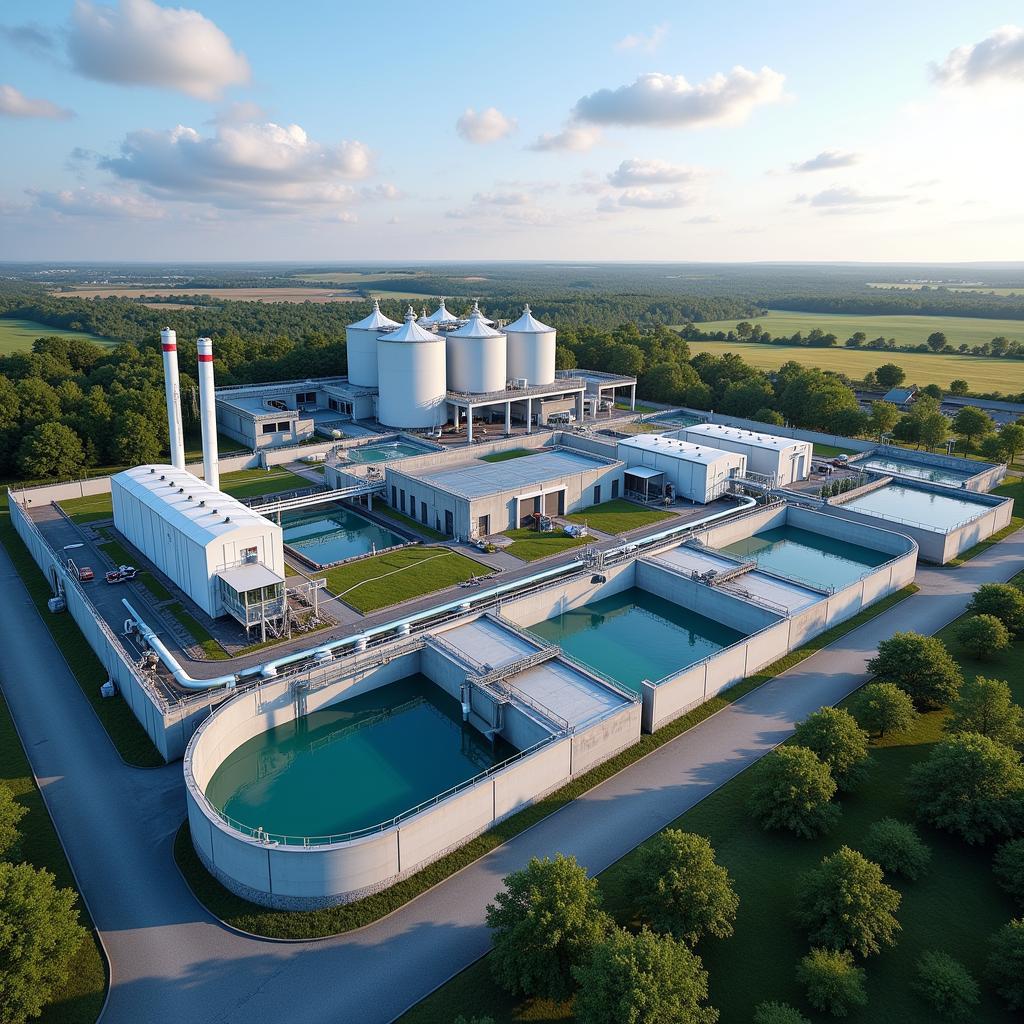The food and beverage industry, while vital for our sustenance and enjoyment, generates a significant amount of wastewater. This effluent, laden with organic matter, nutrients, and potentially harmful contaminants, requires careful treatment before it can be safely discharged or reused. This guide delves into the intricacies of Food And Beverage Wastewater Treatment, exploring the processes, technologies, and importance of responsible management.
 Industrial wastewater treatment plant for food and beverage industry
Industrial wastewater treatment plant for food and beverage industry
Understanding Food and Beverage Wastewater
Wastewater from food and beverage production differs significantly from domestic sewage due to its high concentrations of:
- Organic matter: Sugars, starches, proteins, and fats contribute to high Chemical Oxygen Demand (COD) and Biological Oxygen Demand (BOD) levels, depleting oxygen in receiving water bodies.
- Nutrients: Nitrogen and phosphorus, while essential for plant growth, can lead to eutrophication and harmful algal blooms.
- Suspended solids: Undissolved particles can cause turbidity, impacting aquatic life and increasing treatment costs.
- Fats, oils, and grease (FOG): These substances can solidify in pipes, causing blockages and interfering with treatment processes.
- Chemicals: Cleaning agents, disinfectants, and processing aids can introduce toxicity to wastewater.
Failure to adequately treat this wastewater can result in environmental pollution, health hazards, and hefty fines.
Stages of Food and Beverage Wastewater Treatment
Effective wastewater treatment typically involves a combination of physical, chemical, and biological processes.
1. Pretreatment
This initial stage removes large debris and solids to protect downstream equipment and processes. Common methods include:
- Screening: Removes large solids like packaging materials, labels, and food scraps.
- Grit removal: Eliminates sand, gravel, and other inorganic materials that can damage pumps and other equipment.
- Equalization: Balances flow rate and composition variations, optimizing subsequent treatment processes.
2. Primary Treatment
This stage focuses on separating suspended solids and FOG from the wastewater:
- Sedimentation: Solids settle at the bottom of tanks as sludge, while FOG floats to the surface for removal.
- Dissolved air flotation (DAF): Tiny air bubbles attach to suspended solids and FOG, lifting them to the surface for skimming.
3. Secondary Treatment
The heart of the treatment process, this stage utilizes biological processes to degrade organic matter:
- Activated sludge: Microorganisms consume dissolved organic pollutants as food, converting them into carbon dioxide, water, and more microorganisms.
- Trickling filters: Wastewater is sprayed over a bed of media, allowing bacteria to grow and break down organic matter.
- Anaerobic digestion: In the absence of oxygen, microorganisms decompose organic matter, producing biogas (methane and carbon dioxide) that can be used for energy recovery.
4. Tertiary Treatment
Also known as advanced treatment, this stage removes remaining pollutants to meet specific discharge standards:
- Filtration: Removes residual suspended solids and microorganisms using sand, gravel, or membrane filters.
- Disinfection: Eliminates harmful pathogens using chlorine, ultraviolet light, or ozone.
- Nutrient removal: Reduces nitrogen and phosphorus levels through biological or chemical processes to prevent eutrophication.
Importance of Effective Wastewater Treatment
Implementing robust wastewater treatment practices is not merely a regulatory requirement but an environmental and economic imperative:
- Environmental Protection: By removing pollutants, we safeguard our rivers, lakes, and groundwater from contamination.
- Public Health: Treating wastewater prevents the spread of waterborne diseases and protects public health.
- Water Resource Management: Treated wastewater can be reused for irrigation, industrial processes, or even replenishing aquifers.
- Regulatory Compliance: Adhering to discharge limits avoids hefty fines and legal complications.
- Corporate Social Responsibility: Demonstrating environmental stewardship enhances brand reputation and fosters community goodwill.
Choosing the Right Treatment System
Selecting the most appropriate wastewater treatment system depends on factors such as:
- Wastewater characteristics: Flow rate, pollutant load, and composition.
- Treatment objectives: Required effluent quality for discharge or reuse.
- Space constraints: Available land area for the treatment plant.
- Capital and operating costs: Affordability and long-term sustainability.
Consulting with experienced wastewater treatment professionals is crucial for evaluating specific needs and designing a tailored solution.
Future Trends in Food and Beverage Wastewater Treatment
The industry is constantly evolving to address emerging challenges and embrace sustainable practices:
- Resource recovery: Extracting valuable resources like biogas, fertilizers, and clean water from wastewater.
- Energy efficiency: Implementing energy-saving technologies to minimize operational costs and carbon footprint.
- Digitalization and automation: Utilizing sensors, data analytics, and artificial intelligence to optimize treatment processes.
Conclusion
Effective food and beverage wastewater treatment is an essential responsibility for protecting our environment, conserving water resources, and ensuring the sustainability of this vital industry. By embracing innovative technologies and adopting responsible practices, we can transform wastewater from a challenge into a valuable resource.
FAQ
Q: What are the consequences of not treating food and beverage wastewater?
A: Untreated wastewater can pollute water bodies, harm aquatic life, spread diseases, and lead to legal repercussions.
Q: How can I reduce wastewater generation in my food processing facility?
A: Implementing water-efficient equipment, optimizing production processes, and reusing treated wastewater are effective strategies.
Q: What is the role of regular maintenance in wastewater treatment?
A: Regular maintenance ensures optimal treatment efficiency, prevents equipment breakdowns, and extends the lifespan of the system.
Q: Are there financial incentives for implementing sustainable wastewater treatment practices?
A: Many governments and organizations offer grants, subsidies, and tax breaks to encourage businesses to adopt eco-friendly solutions.
Need assistance with your food and beverage wastewater treatment needs? Contact us today at Phone Number: 02437655121, Email: minacones@gmail.com or visit our office at 3PGH+8R9, ĐT70A, thôn Trung, Bắc Từ Liêm, Hà Nội, Việt Nam. Our dedicated team of experts is available 24/7 to provide customized solutions and support your sustainability journey.